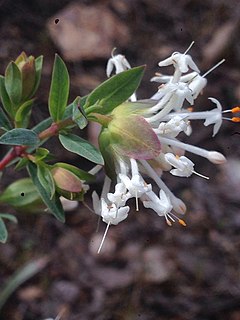
Pimelea linifolia, commonly known as slender rice flower is a common, variable shrub widespread throughout eastern Australia. It has narrow leaves arranged in opposite pairs, and usually white flowers arranged in heads of seven or more on the ends of the stems, with four lance-shaped bracts at the base of the inflorescence. The plant may be toxic to livestock.

Pimelea alpina, the alpine rice-flower, is a species of flowering plant in the family Thymelaeaceae and is endemic to south-eastern continental Australia. It is an erect, prostrate or spreading shrub or undershrub with narrowly elliptic leaves crowded at the ends of branches and heads of pinkish red or white flowers.
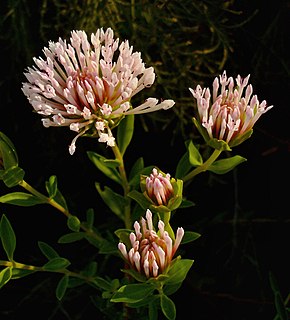
Pimelea calcicola is a species of flowering plant in the family Thymelaeaceae and is endemic to part of the west coast of Western Australia. It is an erect to spreading shrub with elliptic leaves arranged in opposite pairs, and head-like racemes of pale to deep pink, tube-shaped flowers surrounded by leaf-like involucral bracts.

Pimelea ferruginea, commonly known as pink rice flower or coastal banjine, is a species of flowering plant in the family Thymelaeaceae and is endemic to near-coastal areas of south-western Western Australia. It is a dense, erect shrub with elliptic to narrowly elliptic leaves and head-like clusters of pale to deep pink, tube-shaped flowers.

Grevillea humilis is a species of flowering plant in the family Proteaceae and is endemic to eastern New South Wales. It is an erect to spreading shrub with narrowly elliptic to more or less linear leaves, and pink or white flowers.
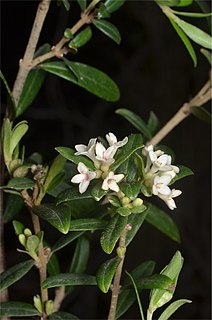
Pimelea drupacea, commonly known as cherry rice-flower, is a species of flowering plant in the family Thymelaeaceae and is endemic to south-eastern Australia. It is a shrub with elliptic leaves arranged in opposite pairs, and head-like clusters of white, tube-shaped flowers surrounded by two or four leaves.

Pimelea sericea is a species of shrub in the family Thymelaeaceae. It is native to Australia, specifically Tasmania. Their common name is mountain rice flower. Pimelea means fat and sericea means silk. The reason could be that Pimelea species usually have oily seeds and fleshy cotyledon. The sericea came from the fact that they are covered with silky hair.
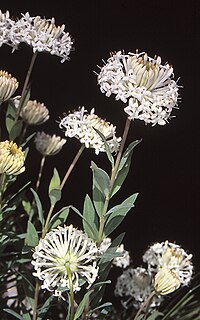
Pimelea treyvaudii, commonly known as grey rice-flower, is a species of shrub in the family Thymelaeaceae. It has white flowers in spherical heads at the end of branches and is endemic to eastern Australia.

Pimelea curviflora, also known as curved rice-flower, is a shrub in the family Thymelaeaceae and is endemic to Australia. It is a small, hairy shrub with greenish-yellow or red tubular flowers.
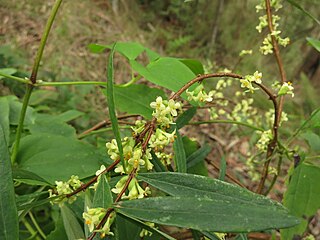
Pimelea axiflora, commonly known as bootlace bush, is a small shrub in the family Thymelaeaceae and is endemic to Australia. It is a small shrub with whitish flowers on mostly smooth stems.

Grevillea goodii, also known as Good's grevillea, is a species of flowering plant in the family Proteaceae and is endemic to the Northern Territory. It is a prostrate shrub with egg-shaped to narrowly elliptic leaves and clusters of light green flowers with a pink to red style.
Epacris exserta , commonly known as South Esk heath, is a species of flowering plant in the heath family, Ericaceae and is endemic to Tasmania. It is an erect shrub with narrowly lance-shaped to elliptic leaves and tube-shaped, white flowers clustered near the ends of the branches.
Pimelea biflora, commonly known as matted rice-flower, is a species of flowering plant in the family Thymelaeaceae and is endemic to south-eastern continental Australia. It is a prostrate, mat-forming shrub with elliptic leaves and dark red flowers always arranged in pairs on the ends of branches.
Pimelea cinerea is a species of flowering plant in the family Thymelaeaceae and is endemic to Tasmania. It is a slender shrub with more or less elliptic leaves, and heads of white flowers surrounded by leaves.

Pimelea cracens is a species of flowering plant in the family Thymelaeaceae and is endemic to the southwest of Western Australia. It is an erect, spindly shrub with narrowly elliptic to egg-shaped leaves and creamy green to pale yellow flowers surrounded by 6 or 8 yellowish or pale green and reddish involucral bracts.

Pimelea trichostachya, commonly known as annual riceflower, spiked riceflower or flax weed, is a species of flowering plant in the family Thymelaeaceae and is endemic to continental Australia. It is a slender, semi-woody, annual shrub with narrowly elliptic or linear leaves and densely hairy, white or yellow flowers and green, purple-tinged fruit. It is toxic to livestock.
Pimelea drummondii is a species of flowering plant in the family Thymelaeaceae and is endemic to near-coastal areas of southern Western Australia. It is an erect, slender shrub with narrowly elliptic or elliptic leaves arranged in opposite pairs, and white or cream-coloured flowers surrounded by 3 or 4 pairs of pale green to yellowish involucral bracts.
Pimelea elongata is a species of flowering plant in the family Thymelaeaceae and is endemic to inland areas of eastern Australia. It is a slender forb with linear to narrowly elliptic leaves and spikes of hairy, yellowish-green flowers.
Pimelea erecta is a species of flowering plant in the family Thymelaeaceae and is endemic to the southwest of Western Australia. It is an erect, often spreading shrub with elliptic to egg-shaped leaves arranged in opposite pairs, and clusters of erect, white or pale pink flowers.
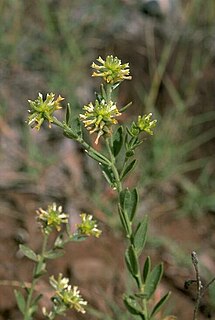
Pimelea confertiflora is a species of flowering plant in the family Thymelaeaceae and is endemic to north Queensland. It is a shrub with densely hairy young stems, elliptic or narrowly elliptic leaves and spikes of yellowish-green or yellow, tube-shaped flowers.














